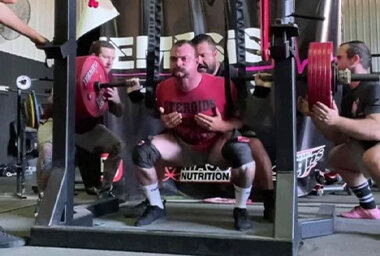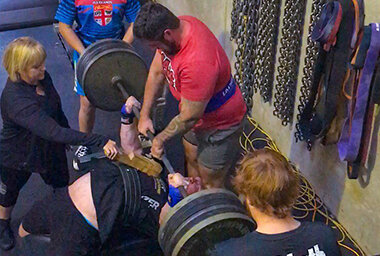
Technical Competition Rules
SQUAT
After removing the bar from the monolift while facing the front of the platform, the lifter must not step either backwards or forwards. The bar shall be held horizontally across the shoulders with the hands and/ or fingers gripping the bar , and the feet flat upon the platform with the knees locked.
The head referee’s signal shall consist of a downward movement of the arm and audible command “Squat”.
The lifter must bend the knees and lower the body until the top surface of the legs at the hip joint is lower than the top of the knees. The lifter must recover at will, without double bouncing, to an upright position with the knees locked.
As soon as the lifter has demonstrated a controlled final position, the head referee will give the rack signal after which the lifter must make a legitimate attempt to return the bar to the racks.
The signal to replace the bar will consist of a backward motion of the arm and the audible command “Rack”.
Once the bar has been replaced in the racks at the completion of the lift and the referees will announce their decisions by means of the lights, white for a “good lift” and red for a “no lift”
BENCH PRESS
The lifter must lie backward with shoulders and buttocks in contact with the flat bench surface. The elected position of the buttocks shall be maintained throughout the attempt. The lifters shoes or toes must be in solid contact with the platform or surface.
After receiving the bar at arm’s length, the lifter shall wait for the “start” signal and then lower the bar to the chest and await the head referee’s Press signal.
After the signal to commence the lift has been given, the bar is pressed upward. The bar shall not be allowed to sink into the chest or move downwards prior to the lifter’s attempt to press upward. The lifter will press the bar to straight arm’s length and hold motionless until the audible command “Rack” is given. Bar may move horizontally and may stop during the ascent, but may not move downward towards the chest.
Once the bar has been replaced in the racks at the completion of the lift and the referees will announce their decisions by means of the lights, white for a “good lift” and red for a “no lift”.
DEADLIFT
Start: No signal required.
Completion: A visual signal consisting of a downward movement of the arm together with the audible command “Down”.
The bar must be laid horizontally in front of the lifter’s feet, gripped with an optional grip in both hands, and lifted until the lifter is standing erect. The bar may stop but there must be no downward motion of the bar.
On completion of the lift, the knees shall be locked in a straight position and the lifter shall be standing erect. The head referee’s signal shall not be given until the bar is held motionless and the lifter is an apparent finished position.
Once the bar has been replaced on the platform at the completion of the lift and the referees will announce their decisions by means of the lights, white for a “good lift” and red for a “no lift”.
Costume and Personal Equipment
Raw
A leotard must be worn for all three lifts.
It must be an individual full-length article of cloth fabric, single ply and must not be made of supportive material. The straps must be worn over the shoulders at all times when lifting in competition. The length of the leg when worn must not exceed beyond mid-thigh.
WRAPS:
- In raw competitions, wrist wraps may only be worn on bench press and squat
- No elbow wraps to be worn in raw competitions
- Knee wraps or sleeves may be worn in the squat
Equipped
SQUAT + DEAD LIFT: lifting suit
It must be an individual full-length article of cloth fabric. Its construction may consist of multiple plies to any thickness but must, as a whole, be a singular component. The straps must be worn over the shoulders at all times while lifting in competition. The length of the leg, when worn must not exceed beyond mid-thigh.
BENCH PRESS: bench shirt
The bench shirt must be an individual article of fabric consisting of cloth or polyester, its construction may consist of multiple plies but as a whole be a singular component.
WRAPS:
Wrist: Wraps not exceeding 1m in length and 8cm in width may be worn, they may have a thumb loop and Velcro patch for securing them the thumb loop must be removed before lifting.
Knees: Wraps not exceeding 2.5m in length and 8cm in width may be worn. Alternatively, elasticized knee supports not exceeding 30cm in length may be worn. A combination of the two is not permitted.
Elbows: Wraps may be worn only during the squat and dead lift competition and not during the bench press.






